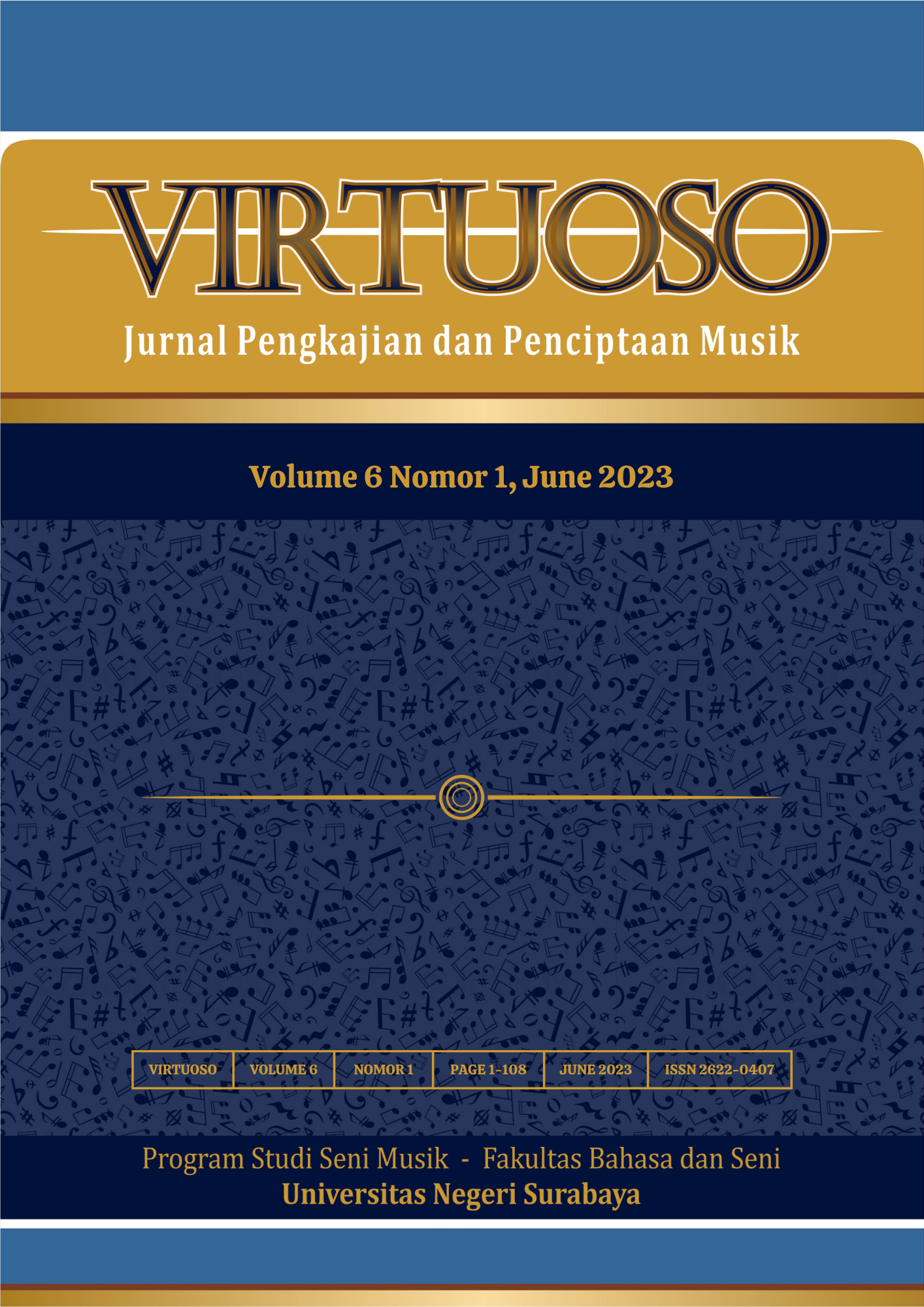A Prototype "Kendang Jaipong" Virtual Instrument as Music Creativity Tools
Main Article Content
Abstract
Numerous organological discoveries in the form of virtual instruments have surfaced as a result of the impact of developing digital music technology. To conserve and promote music based on local culture, organological innovations in the form of virtual instruments, such as the kendang jaipong, must be implemented. The goal of this work is to describe the development of the kendang jaipong virtual instrument from organological investigations through the realization of a marketable prototype. By sampling from the Kendang Jaipong’s actual instrument and converting it into a virtual instrument based on the KONTAKT Library, the technique utilized is practice-led research, also known as practice-based research. Pre-production, production, and post-production are the three stages of the design process. This prototype makes use of 137 samples that are based on a variety of chosen kendang sounds. To enable each type of kendang sound to function as a virtual instrument in DAW and Digital Music Notation programs, the audio samples are organized in a placement system on the keyboard keys included in the KONTAKT feature. The Kendang Jaipong prototype has been successfully tested on several music productions using DAW-cast and video score. The usage of the multi-round robin's function to have a more diversified sample, as well as the addition of the midi files capability, are things that need to be developed on this prototype product so that it may be used as a machine learning by users.
Downloads
Article Details

This work is licensed under a Creative Commons Attribution-NonCommercial-ShareAlike 4.0 International License.
The copyright of the received article once accepted for publication shall be assigned to the journal as the publisher of the journal. The intended copyright includes the right to publish the article in various forms (including reprints). The journal maintains the publishing rights to the published articles.
References
Bodin, D. (2017). Review: Ethno World 6 Complete, Instruments by Marcel Barsotti from BestService. Sample Library Review. https://www.samplelibraryreview.com/the-reviews/review-ethno-world-6-complete-marcel-barsotti-bestservice/
Borgdorff, H. (2016). The Conflict of the Faculties: Perspectives on Artistic Research and Academia (Vol. 15, Issue 2). Leiden University Press. https://library.oapen.org/handle/20.500.12657/32887
Harahap, I. (2004). Alat Musik Dawai (E. L. Siagian (ed.)). LPSN.
Hardjana, S. (2003). Corat Coret Musik Kontemporer Dulu dan Kini (1st ed.). Ford Foundation & MSPI.
Hendriyana, H. (2021). Metodologi Penelitian Penciptaan Karya (P. Christian (ed.); II). ANDI.
Joshi, K. M. (2022). 20 Best Kontakt Libraries For All Categories. https://integraudio.com/20-best-kontakt-sample-library/
Mack, D. (2004). Sejarah Musik Jilid IV (4th ed.). Pusat Musik Liturgi.
Native-instruments.com. (2022). Kontakt 6. Native Instruments. https://www.native-instruments.com/en/products/komplete/samplers/kontakt-6/
pianobook.co.uk. (n.d.). Pianobook. Retrieved August 16, 2022, from https://www.pianobook.co.uk/
http://www.gamelan.org/balungan/back_issues/balungan(9-10)/
Sani, M. B. Z., & Ramadhani, A. M. (2020). Pengembangan Alat Musik Panting Melalui Bentuk VSTi. Pelataran Seni, 4(1), 49. https://doi.org/10.20527/jps.v4i2.8990
Schule, N. (2019). What Are Virtual Instruments. Pragmatic Sound. https://medium.com/pragmatic-sound/what-are-virtual-instruments-c762055ddf71
Siagian, E. L. (2006). Gong. LPSN.
Suparli, L. (2010). Gamelan Pelog Salendro-Induk Teori Karawitan Sunda. Sunan Ambu Press.

